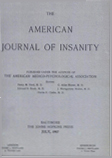ELECTROENCEPHALOGRAMS OF MANIC-DEPRESSIVE PATIENTS
Abstract
Thae EEGs of 81 manic-depressive patients of whom 52 were diagnosed as manic-depressive depressed (MDD), 22 as manic-depressive manic (MDM), and 7 as manic-depressive mixed (MD mixed) were recorded and analyzed. Findings reveal that there is very little change in the EEGs when patients diagnosed as MDD or MDM shift from one phase to another except when the level of consciousness is altered.
Those patients whose EEGs show erratic slow wave disturbances are those whose behavior is unpredictable, regardless of diagnosis.
The majority of the MDD group have A or MS patterns with alpha frequencies of 10 cycles or slower. The MDM majority of the MDM group have MF patterns with alpha frequencies 10 cycles or faster.
Previous studies show a correlation between passive, dependent types of individuals and A patterns, and between agressive, active, independent individuals and MF or B patterns.
It is the author's belief that if a person with an A pattern should develop MD psychosis he will be more apt to be diagnosed as MDD. If he has an MF or B pattern composed of fast frequencies he will be more apt to be diagnosed as MDM or as "agitated depression."
The EEGs have not yet yielded data concerning the factors responsible for the shifts in the manic-depressive phases when the level of consciousness is still unimpaired.
Access content
To read the fulltext, please use one of the options below to sign in or purchase access.- Personal login
- Institutional Login
- Sign in via OpenAthens
- Register for access
-
Please login/register if you wish to pair your device and check access availability.
Not a subscriber?
PsychiatryOnline subscription options offer access to the DSM-5 library, books, journals, CME, and patient resources. This all-in-one virtual library provides psychiatrists and mental health professionals with key resources for diagnosis, treatment, research, and professional development.
Need more help? PsychiatryOnline Customer Service may be reached by emailing [email protected] or by calling 800-368-5777 (in the U.S.) or 703-907-7322 (outside the U.S.).



